March
's Recipe:
Taramosalata
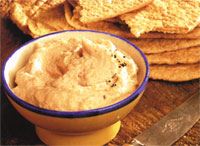
|
|
Ingredients: |
| -
115g/4oz smoked mullet roe |
|
- 2 garlic cloves, crushed |
|
- 30ml/2tbsp grated onion |
|
- 60ml/4tbsp grated olive
oil |
|
- 4 slices of white bread,
crusts removed |
|
- juices of 2 lemons |
|
- 30ml/2tbsp milk or water |
|
- freshly ground black
pepper |
|
- warm pita bread to serve |
|
|
Preparation:
1. Place the smoked fish roe, garlic, grated
onion, oil, bread and lemon juice in a blender or
food processor and process until smooth.
2. Scrape down the edges of the food processor to
ensure that all the ingredients are properly
incorporated. Blend quickly again.
3. Add the milk or
water and process again for a few seconds.
(This will give the taramosalata a creamier
texture.)
4. Pour the taramosalata into a serving bowl, cover
with clear film (plastic wrap) and chill for 1-2
hours before serving. Sprinkle the dip with
black pepper and serve with warm pita bread. |
|
|
Excerpts from:
"The
Food and Cooking of Greece"
Are you missing some pices and incredients for your
recipe?
|
|

ASTORIA
on DVD!
Set in the Queens, New York
neighborhood know as "Little Athens," ASTORIA centers
around a blue-collar Greek-American family as they
struggle to hold on to the American Dream.
|
$24.98 |
 |
|
|
|
Watch Your Manners In Greece |
|
Smoking |
|
Continued from
February
's Issue...
- A pleasurable source of enjoyment or just a foul
habit? The dilemma remains. In the past, smokers had
the law on their side; nowadays they face all sorts
of accusations. Smoking in Greece is still a trend -
Greeks are some of the most voracious smokers in the
world - and although both defenders and accusers
tend to have aggressive reactions, smokers and
non-smokers can live in harmony provided they
understand and respect each others' needs and
desires.
- Since 1 / 1 /2003 the Greek government has ruled
that smoking is forbidden in all indoor public areas
(offices, public waiting rooms, meeting rooms,
assemblies, etc), in all forms of public transport,
in taxis, airplanes and at bus and railway stations,
in lifts or on escalators, in all areas provided for
health services (public hospitals, areas of communal
or public sanitation areas, private clinics,
military hospitals, health centers, blood-donation
centers, diagnostic research labs) or in churches,
cemeteries, theatres or cinemas.
- All restaurants, patisseries, cafes etc are
required by law, as from 1 / 10/2002, to have
special nonsmoking areas. Non-smokers must have at
least 50% of the establishment's total space. The
application of this decree is not necessary for
nightclubs and bars, which only work at night, or at
traditional Greek kafeneia (cafeterias).
- When seated at the dinner table, we should not
light a cigarette as soon as we sit down. Smoking is
usually allowed before or after dessert. We should
not smoke when others are eating, but must wait
patiently until they have finished. It is polite to
ask our hostess's permission to smoke. However,
smoking is such a widespread habit in our country,
that usually it is sufficient merely to ask those
nearby if our smoking would disturb them. If their
answer is yes, we must wait until everyone has
finished eating and has left the table; or we may go
either to the veranda (if it is summer) or into
another room so as not to disturb any non-smokers.
- It is most inappropriate to appear on a date,
enter or exit a house or a restaurant or even dance
while holding a cigarette.
- When introduced to someone older than us, we
should immediately put out our cigarette. If we
cannot bring ourselves to do this, we should at
least refrain from puffing on the cigarette in their
presence.
- If we have invited somebody to a restaurant,
politeness suggests that we ask for a table in
smoking area if our guest is a smoker, even if
smoking bothers us. We ask for our guest's
understanding, however, if we suffer from a serious
health problem and cannot sit in a smoky atmosphere.
- We may smoke in our office if the company or our
employer allows it. We must always, however, bear in
mind that it leaves an unpleasant reek behind us.
- We should never empty our car's ashtray on the
road (yes, this does happen in Greece - drivers tip
out old stubs while waiting at traffic lights or
while stuck in a traffic jam).
- Beware of ash! The carpets of a house should not
be considered an endless ashtray. Nor have coffee
cups been designed for this purpose.
- A gentleman should not await until a lady asks for
light. He should use his perceptiveness and sense of
good timing, and as soon as she removes a cigarette
from her pack he should have a lighter ready.
Excerpt from "Watch Your Manners In Greece" by
Christos K. Zampounis
|
|
|
|
Special Feature: Food & Cooking Suggestions for Lenten
What Greeks eat is intrinsic to Greek
culture. The close connection between
culinary traditions and social or religious
traditions is most evident during Lent and
at Easter, periods when how foods are
prepared and consumed are entwined with the
observance of these religious celebrations.
To the non-Orthodox, the veritable
cornucopia that is the Lenten table and the
tradition of kicking - off Lent with a feast
of delicacies like shellfish, sesame halva,
and glistening olives (not to mention the
hours devoted to their preparation) doesn't
seem to fit their notion of fasting as
abstinence-whether from all food or front
favorite foods. But these Lenten culinary
traditions were not shaped solely by
spiritual or religious notions, but are also
rooted in dietary habits with other
influences.

Lifestyle changes have relaxed Greeks'
adherence to tradition, and the number of
Greeks who strictly observe fasting periods
throughout the year is shrinking, although
most still refrain from eating meat
(including fish with backbones) and animal
products on Kathara Deftera (Clean Monday)
and during Holy Week. And while many Lenten
dishes are common throughout Greece, there
are countless regional variations or
specialties, many handed down from
generation to generation.
"In Cretan tradition, food during Lent was
spare," says Nikos Psilakis, author and vice
president of the Greek Acade my of Taste.
"The day's main meal was often wild
greens-understandably, since March is
greens' best season-or pulses cooked in one
of several ways. Dinner was light, usually
some type of what-based pasta. And, of
course, bread was a staple during Lent,
too."
Lagana is one of Lent's emblematic foods.
This large, flat, yeastless bread is a
modern-day version of the ancient artolagano,
and consumed along with savory foods like
tararnosalata as well as halva or other
sweets with a sesame or tahini base. While
halva is commonly made with sesame in most
parts of Greece, in eastern Thrace, it's
known locally as boulamas and made with
flour and petimezi, a fruit syrup (usually
made from grapes, but sometimes also from
figs). Many Greek sweets like baklava are
also adapted for Lent, with olive oil
substituted for butter so aside from the
phyllo-wrapped nutmeat sweets, the Lenten
dessert table includes fried dough like
diples, deep-fried loukoumades, or
xerotigana-all served drizzled with honey,
cinnamon, and sesame seeds.
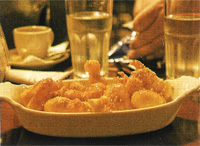
"There are numerous culinary options for
Lent," says chef Aryiro Barbarigou, owner of
Papadakis Restaurant on Paros and author of
Aegean Recipes. "On the islands, we usually
eat a lot of octopus-stewed with orzo and
tomato paste or barbecued, a great meze for
tsipouro. Calamari and squid can also be
cooked with spinach or local, wild greens-a
very tasty dish. And of course vegetable or
pulse stews, with an olive oil base, are
also popular."
Overnight, Greek palates make the transition
from Lenten to Easter flavors. After forty
days of abstaining from meat and animal
products, the digestive system needs to be
eased into the heavier culinary pleasures of
Easter foods. This task falls to mayiritsa,
the steaming soup served after the Anastasi
service, along with hard-boiled eggs (dyed a
deep red on Good Thursday). "The basic dish
is a lemony soup made with finely chopped
pieces of lamb's liver, lettuce, dill, and
spring onions," says Cretan chef Petros
Kosmadakis, a collector of traditional
recipes. "Of course, there are regional
variations. In some parts of Greece, rice is
added to the soup; in other, chopped lamb's
intestines are stirred in just before the
avgolemono is added. On Crete, it's the only
food we serve after the Anastasi, along with
boiled eggs and kaltsounia made with fresh
anthotiro and mint."
Lamb (or goat on the islands) is the
traditional Easter meat served throughout
Greece, although how it's cooked varies from
region to region. Spitroast lamb, which
originated in Roumeli, is now the prevalent
tradition, but many areas preserve their
distinctive way of preparing the Easter
dish. On many islands - including Andros,
Samos, Naxos, and Rhodes - lamb is stuffed
with rice and herbs then baked in the oven.
The Eater table is also laden with crsip
lettuce salads flavored with dill and spring
onions, special breads like lambrokouloures
and tsoureki, and rich, fresh cheeses. On
the mainland, these are served plain, while
on my islands, these creamy cheeses are
served in baked goods like kaltsounia. On
Crete, cheese and meat are combined in a
single, brilliant dish: kreatotourta (meat
cake), a pie made with sweet and sour
mizithra cheese, lamb's meat, mint, and
cinnamon.
Excerpts from:
ODYSSEY magazine
|
|
|
What's
New!!! |
|
Music &
DVDs |
|
|
|
Books
& Software |

Illustrated Sports Encyclopedia , In Greek |

Six Language Visual Dictionary |

Illustrated Junior Sports Encyclopedia, In Greek |

Athens Scenes from a Capital City by John Cleave
|

Xenophon's Cyrus the Great : The Arts of Leadership and
War, edited by Larry Hedrick |

The Peloponnesian War : Athens, Sparta, and the Struggle
for Greece by Sir Nigel Bagnall |

Songs on Bronze : The Greek Myths Made Real, by Nigel
Spivey |

Low-Fat Lies High-Fat Frauds and the healthiest diet in
the world by Vigilante and Flynn |

A to Z Greece by Byron Augustin and Rebecca A. Augustin,
in English
|

Greece! Rome! Monsters! by John Harris, in English |

Lose Weight on the Mediterranean Diet, by Elisabeth
Havlicek-Kastanaki
|

Elliniko Gevma & Pardiko Party by Nikos Tselementes |

Systran Gold ver.5.0, English <-> Greek Translation
Software |
|
|
|
|
Vigil
Oil Candles |
|
|
|
New
Additions! |
|
|
|
Traditional
Greek Costumes |
|
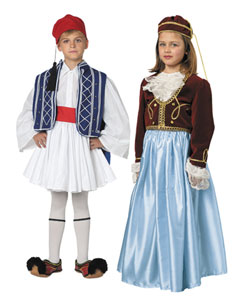
The Traditional costumes of Tsolia and Amalia are here
and on time for the National Greek Holiday of March
25th! Handmade in Greece, these high quality costumes
include vest, fez (hat), skirt, tufts, and stockings for boys,
and skirt, vest, and fez for girls. Available in a
variety of sizes for children ages
1 to 14.
Please allow 2-3 weeks for delivery.
For more information,[click
here]
|
|
|
Featured Destination: Siphnos
|
|
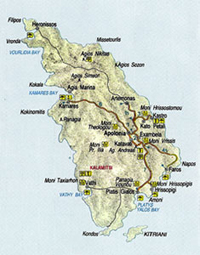
GEOGRAPHY. The fourth isle of the Western Cyclades
lies between Seriphos, Kimolos and Antiparos. Seriphos
is 74 sq. km. in area, has 70 km. of coastline and is 76
nautical miles from Piraeus. There is a car and
passenger ferry from Piraeus every day, as well as
connections with Seriphos, Kimolos and Melos, while
during the summer there is a local service with Paros.
The island's capital is Apollonia and its population is
2,027. A mountainous island (highest peak Profitis Ilias,
680 m. a.s.l.) intersected by small, fertile plains in
the bays and along the coast. It also has considerable
mineral wealth (schistose rocks, marble, granite and
limestone). With its shining white houses, countless
churches and lovely landscape, Siphnos is ideal for
those seeking a quiet, island atmosphere, as well as for
those wishing to combine relaxation with sophistication
and company. The island is quite well equipped to cater
for tourists and there are regular communications.
HISTORY. In ancient times Siphnos was extremely
wealthy on account of its gold, copper and silver mines.
It was first inhabited by Karians and Phoenicians who
called it Akys or Meropia. Later it was called Minoa by
the Minoans who settled there. In historical times it
was colonised by Ionians and experienced a splendid
floruit, as exemplified by the Siphnian Treasury, votive
to the god Apollo in his sanctuary at Delphi.
Prehistoric remains have been located at Kalamitsi,
Aghios Andreas and Aghios Nikitas. Siphnos took part in
the Persian Wars and afterwards joined the Athenian
League. In Hellenistic and Roman times it followed the
same fate as the other Cyclades and in the Byzantine
period belonged to the Thema of the Aegean. Between 1207
and 1269 it was subject to the Venetian Duchy of Naxos.
It was pillaged by Barbarossa in 1537 but only
capitulated to the Turks in 1617, until which date the
Gozzadini overlords managed to maintain their dominance.
Siphnos played an active role in the 1821 Revolution and
was liberated at the same time as the rest of the
Cyclades.
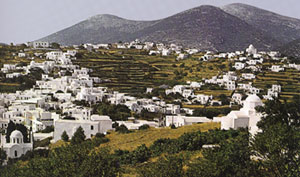 SIGHTS-MONUMENTS.
Apollonia, the island's capital, is built in its
hinterland, spreading amphitheatrically over three
hills. Its narrow streets with whitewashed paving stones
are flanked by two-storeyed, brilliant white Cycladic
houses, mansions of old families and churches (Virgin
Ouranophora, Saviour, St. Sozon). North of Apollonia is
the private convent of the Theologian tou Moungou. In
town there is a folklore collection. 1.5 km. northeast,
at a higher level, is picturesque Artemonas with its
windmills on the crest of the hill and a stunning view.
North of Artemonas is the Hellenistic tower of Kastanas.
A pathway leads from Artemonas, through the olive groves
and vineyards, to Kastro (there is also a metalled road
from Apollonia, which is less picturesque). Kastro,
built on a sheer cliff on the east side of the island
overlooking the sea, has been inhabited since
prehistoric times. Excavations have brought to light
some finds from the Early Bronze Age, but mainly of the
Geometric, Archaic and Classical eras. This was the
island's capital until 1836 when it was transferred to
Apollonia. Traces of the ancient acropolis on the
northwest slope of the hill have been revealed in
excavations conducted by the British School of
Archaeology, as well as the foundations of houses dating
to the 8th and 7th century BC. The castle we see today
was thus arranged in the 14th century and is
architecturally similar to those on Kimolos, Antiparos,
Sikinos and Pholegandros, where the houses are built one
joined to the other, forming the external enceinte, and
parallel with these is a second, internal row of houses.
Several of the many churches within the castle have
survived (St. Eleousa, Dormition, St. Catherine, St.
Demetrius, Forty Saints). Housed in the old Catholic
church of St. Anthony of Padua is a small archaeological
collection. At Seralia, southeast of Kastro, remains of
the medieval harbour installations are preserved. SIGHTS-MONUMENTS.
Apollonia, the island's capital, is built in its
hinterland, spreading amphitheatrically over three
hills. Its narrow streets with whitewashed paving stones
are flanked by two-storeyed, brilliant white Cycladic
houses, mansions of old families and churches (Virgin
Ouranophora, Saviour, St. Sozon). North of Apollonia is
the private convent of the Theologian tou Moungou. In
town there is a folklore collection. 1.5 km. northeast,
at a higher level, is picturesque Artemonas with its
windmills on the crest of the hill and a stunning view.
North of Artemonas is the Hellenistic tower of Kastanas.
A pathway leads from Artemonas, through the olive groves
and vineyards, to Kastro (there is also a metalled road
from Apollonia, which is less picturesque). Kastro,
built on a sheer cliff on the east side of the island
overlooking the sea, has been inhabited since
prehistoric times. Excavations have brought to light
some finds from the Early Bronze Age, but mainly of the
Geometric, Archaic and Classical eras. This was the
island's capital until 1836 when it was transferred to
Apollonia. Traces of the ancient acropolis on the
northwest slope of the hill have been revealed in
excavations conducted by the British School of
Archaeology, as well as the foundations of houses dating
to the 8th and 7th century BC. The castle we see today
was thus arranged in the 14th century and is
architecturally similar to those on Kimolos, Antiparos,
Sikinos and Pholegandros, where the houses are built one
joined to the other, forming the external enceinte, and
parallel with these is a second, internal row of houses.
Several of the many churches within the castle have
survived (St. Eleousa, Dormition, St. Catherine, St.
Demetrius, Forty Saints). Housed in the old Catholic
church of St. Anthony of Padua is a small archaeological
collection. At Seralia, southeast of Kastro, remains of
the medieval harbour installations are preserved.
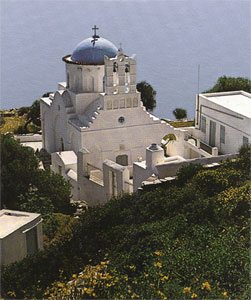 A
short distance to the southeast of Apollonia are the
villages of Exambela (2 km.), birthplace of the poet
Aristomenis Provelengios (further south is the 16th
century Vrysi monastery), Kato Petali, (with the nearby
monastery of Chrysostom, built in 1550) and Katavati (3
km.). A path leads from here to the hill of Aghios
Andreas, on which stands a church of that name, built in
1890. Prehistoric finds discovered in this region
confirm its continuous habitation from Mycenaean till
Hellenistic times. There are quaint little villages at
Platys Yalos (10 km. south of Chora) and at Vathy (where
there are also potters' workshops). Northeast of Platys
Yalos is a ruined Hellenistic tower and, on an eminence
above, the monastery of the Virgin of the Mountain. On a
spit in the gulf of Faros stands the 17th century
monastery of the Virgin Chrysopigi, protectress of the
island. The monastery of the Taxiarchs is situated above
Vathy and that of Prophet Elijah in the island's
interior is the most important Byzantine monument on
Siphnos, dating back to the 8th century, according to
tradition, and with a 12th century marble iconostasis in
its katholikon. A
short distance to the southeast of Apollonia are the
villages of Exambela (2 km.), birthplace of the poet
Aristomenis Provelengios (further south is the 16th
century Vrysi monastery), Kato Petali, (with the nearby
monastery of Chrysostom, built in 1550) and Katavati (3
km.). A path leads from here to the hill of Aghios
Andreas, on which stands a church of that name, built in
1890. Prehistoric finds discovered in this region
confirm its continuous habitation from Mycenaean till
Hellenistic times. There are quaint little villages at
Platys Yalos (10 km. south of Chora) and at Vathy (where
there are also potters' workshops). Northeast of Platys
Yalos is a ruined Hellenistic tower and, on an eminence
above, the monastery of the Virgin of the Mountain. On a
spit in the gulf of Faros stands the 17th century
monastery of the Virgin Chrysopigi, protectress of the
island. The monastery of the Taxiarchs is situated above
Vathy and that of Prophet Elijah in the island's
interior is the most important Byzantine monument on
Siphnos, dating back to the 8th century, according to
tradition, and with a 12th century marble iconostasis in
its katholikon.
At Kamares, the island's port, there are potters'
workshops. From here one can take a boat trip to the
bays of Vathy, Platys Yalos and Faros with their
shallow, sparkling waters and sandy shores. There are
other beaches suitable for swimming at Kamares,
Chrysopigi, Seralia below Kastro and Chersonisos, which
is a long way off and can be reached by caique. There is
a refuelling station for boats at Kamares. Accommodation
is available in hotels, of which there are several,
pensions and rented rooms.
|
|
|
|
Travel
Guides and Information for your trip in the area |

Going to Live and Work in Greece
2005 edition |

Let's Go Greece 2005 edition - 20% off |

Greece Road Map Set - 10 maps |

Greece - A Guide to the
Archaeological Sites - Travel Guide |

Cruise Greece DVD |
| |
|
Saints'
Namedays in
March
|
|
Monday |
Tuesday |
Wednesday |
Thursday |
Friday |
Saturday |
Sunday |
|
|
|
1
Eudokias / Tis Tyrofagou/ Marias Aigyptias
|
2
Euthalias |
3
Kleonikou |
4 |
5
Kononos |
6
|
7
Laurentiou |
8
Theofulaktouu |
9
|
10
|
11
|
12
|
|
13
|
14
|
15
|
16
Xristodoulou |
17
Alexiou
|
18
Kurillou |
19
Xrysanthou |
|
20 |
21
Iakovou |
22 |
23
|
24
|
25
Euagelismos tis Theotokou |
26
|
27
Ilarionos |
28
|
29
|
30 |
31
Ypatiou |
|
|
|
|
Icons
depicting the celebrated Saint, make great gifts for
namedays.
Shop among our great collection of icons at our
store. Also available, namedays, birthday, holiday, and
special occasion greeting cards.
|
|
Share
With Others!!!! |
Let your family and friends share the savings by
forwarding them this email.
|
|
Suggestions
& Comments |
Dear Greekshops.com customer,
Thank you for contributing to our effort to bring
unique and hard to find Greek products to your home. We
value your opinion, so please let us know if you have
any concerns, suggestions, comments that will improve
and help us grow. Send us your feedback at:
[email protected]
|
|
Subscription
Information |
|
Missed an issue of our
newsletter? Now you can access past newsletters by
visiting
http://www.greekshops.com/newsletters_archive
To
unsubscribe from this email list please reply back
to this email and change the Subject of your email
to REMOVE. You can also unsubscribe by
clicking here
|
|
|
|

